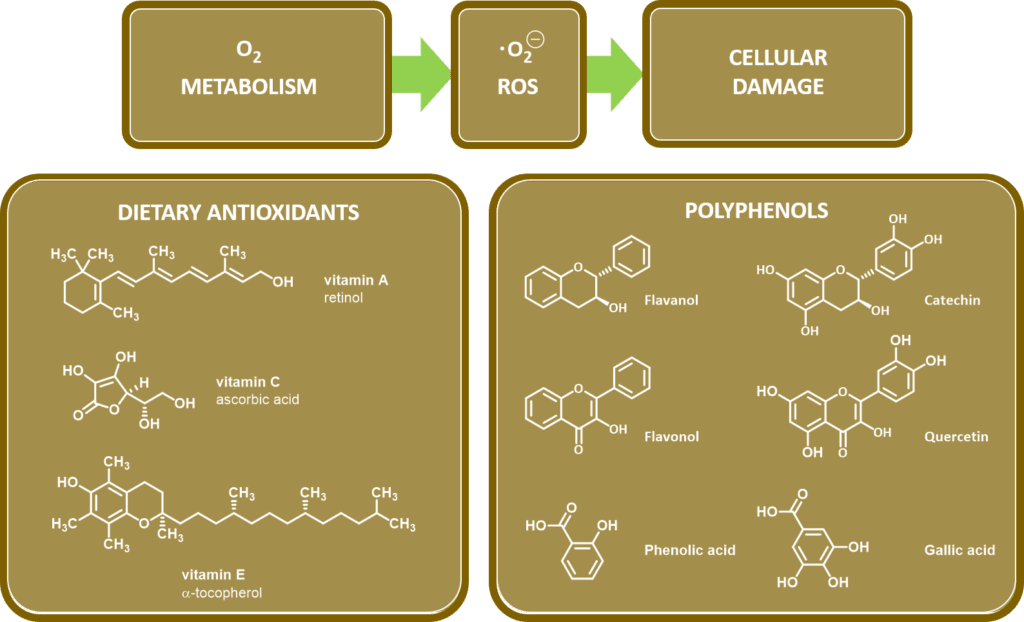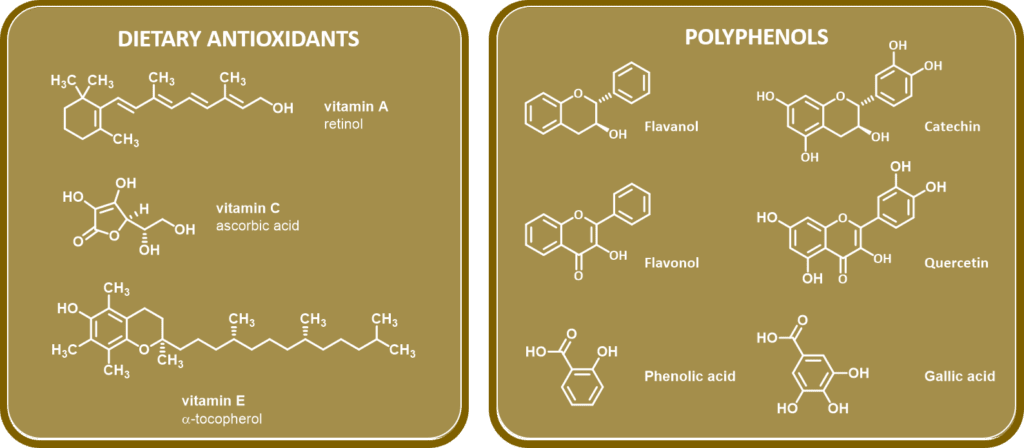Free radicals formed by oxidation reactions are reactive compounds that have an unpaired electron and can cause food spoilage and damage to cells in the human body, possibly leading to cancer and heart disease. Antioxidants are chemical compounds that slow down oxidation by reacting with, or scavenging, free radicals.
Vitamins A, C, and E are dietary antioxidants. Common antioxidants used as food preservatives include natural antioxidants ascorbic acid and tocopherols and synthetic antioxidants like propyl gallate, tertiary butylhydroquinone (TBHQ), butylated hydroxyanisole (BHA) and butylated hydroxytoluene (BHT).
Antioxidants can be classified as enzymatic or non-enzymatic, synthetic or natural (see Flieger for a good summary of classification). Foods like red wine, cocoa, and black and green tea are high in compounds called phenolic phytochemicals that have antioxidant activity, e.g., theaflavin, epigallocatechin gallate, resveratrol, and procyanidin. Of these foods, cocoa contains the highest amounts of total phenolics, gallic acid equivalents, and flavonoids per serving (Lee 2003).
Experiments in vitro (e.g., in a test tube) have shown that many compounds have antioxidant activity. Activities include direct scavenging of free radicals, activating antioxidant enzymes, chelating metals, and inhibiting oxidases (Prochcházková 2011).
Flavanols are the most consumed subclass of flavonoid antioxidants in food. High amounts are found in black and green teas and moderate amounts in berries and dark chocolate (~300 mg per 8 oz of tea, 8 – 60 mg per cup of berries, and ~20 mg/18 g dark chocolate) (Crowe-White 2022).
A metanalysis of 157 randomized controlled trials and 15 cohort studies was done to look at the effects of flavanols on human health (Crowe-White 2022). Measurement of biomarkers like systolic blood pressure, total cholesterol, HDL cholesterol, and insulin/glucose levels in literature studies suggest that consuming 400 – 600 mg of flavanol in food per day can help improve blood pressure, cholesterol, and blood sugar.


Próximamente versión en español
Entry added: July 31, 2023
Verified on: September 14, 2023
Authored by
Cory G. Toyota, Associate Professor of Chemistry and Biochemistry
Academic / university faculty
References
“Antioxidants: Classification, Natural Sources, Activity/Capacity Measurements, and Usefulness for the Synthesis of Nanoparticles,” Jolanta Flieger, Wojciech Flieger, Jacek Baj and Ryszard Maciejewski, Materials (Basel), July 25, 2021.
“Antioxidant and prooxidant properties of flavonoids,” D. Procházková, I. Boušová and N. Wilhelmová, Fitoterapia, June 2011.
“Cocoa has more phenolic phytochemicals and a higher antioxidant capacity than teas and red wine,” Ki Won Lee, Young Jun Kim, Hyong Joo Lee and Chang Yong Lee, J. Agric. Food. Chem., December 3, 2003.
“Flavan-3-ols and Cardiometabolic Health: First Ever Dietary Bioactive Guideline,” Kristi M. Crowe-White, Levi W. Evans, Gunter G. C. Kuhnle, Dragan Milenkovic, Kim Stote, Taylor Wallace, Deepa Handu and Katelyn E. Senkus, Adv. Nutr., December 22, 2022.
Have a comment on this definition?
